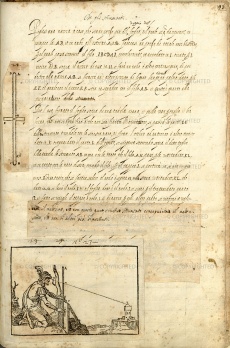Mace
From Inventions
Name adopted by the inventor for its resemblance to the weapon of this name.
Contents |
Inventor
Ludovico Cigoli
Historic Period
ca. 1610
Description
Perspective instrument used mainly in the military field – as indicated by the engraving illustrating its operation in Ludovico Cigoli’s treatise on perspective – to draw views of fortresses rapidly. Its name probably derives from one of the most common side-arms used since the Middle Ages, the mazza, a sort of cudgel terminating in a metal cap. The instrument consists of a grooved wooden rod along which slides a string with a knot and a noose. The knot serves to intersect the visual rays, while the noose serves to transfer the intersection points onto the drawing paper. Fixed orthogonal to the centre of the rod is a rule that serves as guide for the mazza as it slides along the edge of the drawing board with its sheet of paper. When the board is positioned vertically with the rule on its upper edge, the mazza lies half on the board while the other half rises freely before the observer’s eye. Having sighted any point on the object to be drawn, the soldier moved the mazza and let the string slide to bring the knot onto the sighting line. Having done this, he simply transcribed the position of the noose on the sheet of paper, repeating this operation for all of the object’s significant points.
Bibliographical Resources
Cardi Cigoli, Ludovico. Prospettiva prattica, ms. (1613), Firenze, Gabinetto dei Disegni e delle Stampe, 2660 A, c. 96r.
Existing Instruments
Firenze, Museo Galileo-Istituto di Storia della Scienza, modello (2001).
Images
Author of the entry: Filippo Camerota

